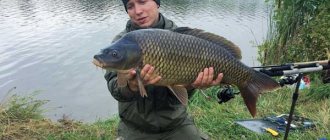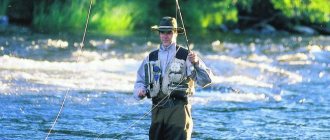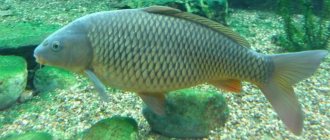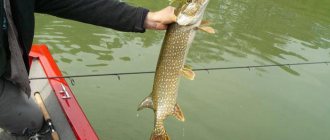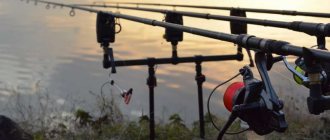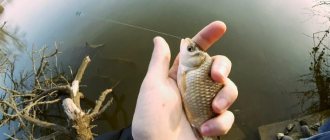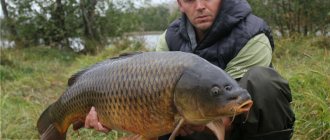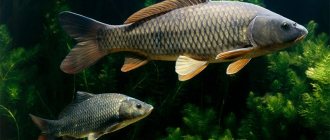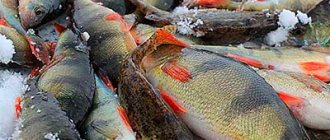A fishing rod with a side nod is a rather unusual tackle, in which, instead of a float, a “side nod” is attached to the edge of the rod, and a summer jig is used as bait. Fishing with a side nod is quite popular among our anglers, as it allows you to fish in areas densely covered with aquatic vegetation. Even if we take fly fishing rod, which is also intended for fishing in conditions of dense vegetation and hard-to-reach places, then all the same, there is a high probability of the float getting caught on obstacles. At the same time, the jig freely reaches the bottom. Another plus is that the nod gives play to the jig, even with a slight swing of the rod.
A fishing rod with a side nod is used to catch roach, bream, carp and crucian carp. If you additionally bait the jig hook with animal bait (bloodworm, caddis larva, maggot), then there is a chance of catching a pike or pike perch; a perch can also bite on a reelless jig.
First of all, such tackle should be used for summer fishing, when it is hot and neither the feeder nor the float gives results, but a fishing rod with a side nod allows you to catch a fairly large carp.
This tackle is excellent for fishing in reeds, as well as in places with densely overgrown vegetation.
Very often, using a fishing rod with a side nod, active fishing is carried out in a wade, when the fisherman moves along the reservoir, fishing promising areas.
How to choose a fishing rod for a side nod
Rod characteristics
In order for fishing with a side nod to be comfortable, it is necessary to select a light and balanced rod, moreover, it must have a small windage and be rigid. During the fishing process, you will constantly have to hold the fishing rod in your hand, making movements, playing with a jig, and here, unlike winter fishing, the quality of the game depends not on the nod, but on the form.
There are no special fishing rods designed for lateral nod fishing; for these purposes, it is best to use reinforced flywheel carbon-fiber telescopic blanks with fast action. These rods allow you to make quick and high-quality hooking, control the fish when playing and bring it to the shore at an accelerated pace. Also, for these purposes, you can use Bolognese fishing rods.
The presence of rings on the blank is necessary when you are fishing with a sliding rig (large fish, fishing from steep banks, presence of current). For small and medium-sized fish, in conditions of a standing reservoir, a rod without guide rings and blind equipment is sufficient.
Since fly fishing rods do not have guide rings, to fish with a sliding rig, you will need to attach them yourself.
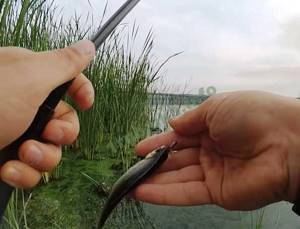
The choice in favor of telescopes is made due to the fact that fishing with a rod with a side nod takes place in a wade, besides, you are constantly moving from place to place, fishing promising areas, and forms with a plug connection will significantly reduce your mobility.
Fast action rods are minimally susceptible to uncontrolled tip vibrations, which negatively affect the performance of the jig.
The length of the fishing rod will depend on the fishing conditions:
- When fishing from a boat or on a small river, a long rod with a side nod is not particularly needed, a 5-6 meter blank is enough. If you are on a boat and the depth at the fishing point is no more than 3 m, then the length of the form can be reduced to 4-4.5 m.
- On large rivers and ponds, it is necessary to use rods 7-8 m long, while such rods are universal and allow you to fish comfortably in various conditions (except for a boat).
- When fishing on large bodies of water, when you need to reach a hole or fish a large area of the shallows, you need to use a 9 m long form. Of course, the weight of such fishing rods begins to make itself felt, and not everyone will be comfortable fishing with such rods.
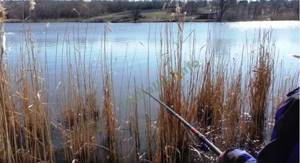
Gear device
You can fish with such gear after the ice cover has disappeared on rivers and lakes, during floods and floods. The absence of the usual float provides many advantages:
- Thanks to the vertical wiring of the jig, the fishing rod can be used in areas overgrown with reeds and heavily snags without fear of snags. Opportunity to fish from bridges, steep banks and rocks, boats.
- Precise delivery of bait to the fish's resting place.
- When fish are actively biting, a jig does not require live bait - the catchability of the gear increases.
- Simplicity of making a nod and its low cost.
- The lightness and mobility of the fishing rod allows the fisherman to fish a large area of water.
The requirements for the nod itself are quite strict - it must have sufficient elasticity to withstand the weight of the jig, and be moderately flexible to inform about the bite.
Advice. When choosing a nod for a specific jig, hook the hook to the tip of the nod. It should deviate from the horizontal by an angle of approximately 30 - 40. If more, the nod is too soft.
Side nods for summer fishing are usually made somewhat longer and larger than their winter counterparts. For a 6-meter fishing rod, its length is 20 centimeters. The nod must be painted in a dark color with a bright stripe, and for better perception a small ball or ring can be placed on the tip. It should not tire your eyes when you watch it for a long time.
There is no single option for how best to place the nod - perpendicular to the form or as an extension of the rod. The lateral position is better visible, while the longitudinal position makes it easier to hook fish.
The nod for a summer fishing rod is mounted on one of the types of tackle described above. Bolognese types of fishing rods are equipped with inertial reels with low mass and without any type of additional functions.
It is enough to have only a stopper in the mechanism; otherwise, the reel serves only to store a supply of fishing line. The fly tackle is equipped with a miniature foam reel, which is attached to the last knee of the blank with an elastic band.
As in bologna, the reel plays the role of storage. The rest of the equipment does not depend on the type of gear and consists of a monofilament line with diameters from 0.15 to 0.2 mm, the nodding accessory itself, complete with its attachment to the quivertip of the rod and the bait.
In installations, a combined artificial bait is used in the form of various types of jigs with different loads.
Important! The bait is tied directly to the fishing line, without swivels or fasteners.
Particular attention should be paid to the use of equipment associated with the difference between rods.
Important! It is more convenient to fish with fishing rods and reels from a boat, and it is more comfortable to work with fly gear from the banks and into wades.
Fishing with a nod in summer is carried out in intensively overgrown reservoirs in free windows and gaps at depths of up to three meters. Fishing is carried out from the shore, in wades and from boats.
The flow of the reservoir does not have any special significance on hunting. Loads from water jets are compensated by the amount of bait supplied to the production area.
Fishing in the fall with a fishing rod with a nod, as in the spring, when the reservoirs are still loosely overgrown with underwater algae, is carried out in coastal areas near the walls of reeds or cattails.
Hunting attempts are successful on steep banks with the presence of underwater holes, from where the play of jigs lures out the fish hiding there. Fishing with a nod in the summer begins at the first dawn and can be successfully carried out throughout the daylight hours until deep sunset, especially if you fish shaded shores.
In early spring and autumn, fish begin to actively take jigs closer to noon, which is especially noticeable on sunny days with more intense heating of the waters and the brightness of the natural light flux.
Despite the fact that one of the main elements of equipment is a jig, the difference between summer and winter fishing with it is huge. Firstly, the rod here is completely different, and accordingly, the jig is matched to it. It is larger than the winter one and heavier.
- Rod
- fishing line
- Nod
- Mormyshka
- Equipment
- How to do a side nod
For fishing with a jig from the shore or wade, a rod with a length of 6 meters is suitable, so tackle for fishing in summer with a side nod is slightly inferior to winter in sensitivity, but when compared with a float, it is the side nod that makes it more catchy.
In summer you can catch a wide variety of fish with a jig. Most often, such tackle is prepared for bream, roach, and silver bream; you can also successfully catch crucian carp and carp.
For fish that live in the upper layers of water, jigs are not used in summer.
To prevent the fishing rod from tiring the angler, it must be assembled correctly. All elements are carefully selected taking into account the reservoir and the size of the intended production.
The most expensive part of the tackle will be the rod. There is no need to skimp on this element.
Recommendations for choosing in the store
Any fishing rod that is not suitable for fishing with a side nod. First of all, you should discard cheap universal Chinese fishing rods. Also, you should not take fishing rods for which you cannot purchase spare elbows and replace them. Believe me, when actively fishing and moving from place to place, breakdowns cannot be avoided, and if you cannot replace the knee, you will have to purchase a new rod.
You should not take rods designed for light tackle, which allow you to enjoy the game of 200 gram roach; such forms will bend under the weight of the nod.
Carp blanks are also not an option, since most of them do not have the necessary rigidity, since in most cases they have a slow action (that is, they bend evenly along their entire length).
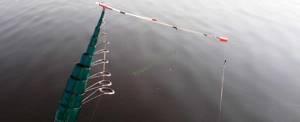
First of all, look for forms that are characterized as reinforced fly rods, designed to work with equipment weighing 20-25 grams.
But now, the most important thing is that the longer the rod is, the better and more expensive the blank should be. The fact is that it is difficult to balance length, weight, windage and stiffness, with the same class of material. And if we increase some parameter, the rest begin to suffer, and the longer you take the form, the higher should be the class of the material from which it is made, and accordingly the price, which can increase by 30-40%.
Fishing rod with side nod, model selection
- As an inexpensive model, you can purchase a blank - Sabaneev Universal , up to 6 m long, suitable for catching both large and medium-sized fish, it works especially well from a boat in densely vegetated areas.
- TICA PREMIERE - 4.8-5.8 m long and 30-60 grams of dough, a powerful blank (this rod was developed for sea fishing from rocks). You can use it to catch carp weighing up to 10 kg. The blanks are 5.8 m long, a little heavy, it is more comfortable to fish with rods 4.8 m long.
- Catching a large carp weighing 15-20 kilograms with a side nod requires a more powerful form, for example - MAVER WINNER FLAME. The test of this rod is 100 grams, it is heavier than the TICA PREMIERE, but also has a safety margin for a more substantial trophy.
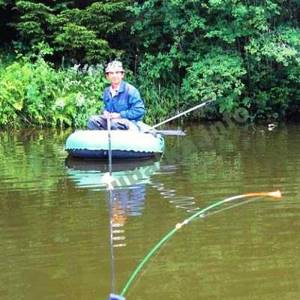
- Tica Winner 2000 is a budget stick; you can use blanks up to 8 m long.
- Maver Z-03 is a good model; blanks up to 8 m long work well; if you take a rod 9 m long, you can fish with it, but the quality will noticeably drop compared to even a figure eight.
- Maver Legend 50 is a higher quality and more expensive option, rigid and perfectly balanced, works great in lengths up to 9 m.
All these fishing rods either have spare elbows, or you can order them, or they fit from other fishing rods.
Fishing with a side nod, choosing gear
Coil
For catching small fish: roach, silver bream, you can get by with an ordinary reel, which is necessary only for storing fishing line, but for bream, crucian carp and carp, it is better to get a small inertia-free reel with a 2500-3000 spool and a friction brake.
fishing line
Depends on the size of the fish you are going to catch. Often, fishermen use fishing line with a thickness of 0.16-0.2 mm. You can use both braided and monofilament fishing line, the only thing is that for braided you need to have a high-quality fishing rod with guides with inserts made of Gold Cermet, SiC or aluminum oxide, otherwise hard braid will quickly wear out the grooves in them.
Mormyshka
Summer fishing with a side nod involves the use of larger jigs than in winter, this is due to the fact that in the summer the fish are more active, and a large jig is more likely to tempt it. As a rule, jigs made of lead and its alloys are used, reaching 3 mm in thickness and up to 6 mm in length. In currents, you may need heavier jigs made of tungsten. Their weight is adjusted to the strength of the current.
A relatively simple and at the same time very catchy method is the use of ordinary jigs (round or oval), with a bloodworm, maggot or other attachment attached to their hook.
Fishing with reelless jigs requires certain dexterity and skills. An important factor when choosing a rewinder is its shape and color. At the same time, it is desirable to have a fairly wide selection of jigs of different shapes and colors, since fish preferences may vary depending on the reservoir and species.

So, in the summer, fishing for chub with a side nod is quite effective with dark-colored jigs (gray, brown, black). Roach and bream prefer jigs of bright colors: red, yellow, orange; their combination with black is also allowed. As for crucian carp, it does not respond so effectively to reelless baits; for it, it is better to have animal baits on the jig.
When going to a pond, it is advisable to have a set of different jigs with you, since it is impossible to say which particular jig will work today. Typically, a fisherman's arsenal includes the following jigs:
- Uralka;
- A drop;
- Devil;
- Goat;
- Carnation;
Of course, if you are a beginner, then you should not chase variety. It’s better to determine for yourself several types of catchable jigs and hone the quality of playing them. But in order to differentiate between them, it is worth decorating the shank of the hook with various jewelry (cambrics, beads, threads, feathers, sequins, etc.)
One of the most universal baits for fishing on a fishing rod with a side nod is the devil. The fact is that it has three hooks, so we can equip it with both animal baits and jewelry.
Rod
The rod for side nodding must meet the following requirements:
- Lightness is the most important component of a fishing rod using a side nod. While fishing, it will be in your hands all the time, and it is not always possible to lower it onto the stand. It is better to give preference to modern carbon fiber rods made of high modulus graphite. Their weight ranges from 150 to 200 grams;
- length – the longer the better. Fishing in this way is carried out vertically, so it is the maximum size of the rod that will determine whether you will reach the place where the fish stop and feed or not. A rod for fishing with a side nod from the shore is usually from 5 to 7 meters, from a boat a little shorter - about 4 meters;
- with or without rings, depends on what kind of fish you intend to catch. For small and medium size - we use a blind rod, for large fish, fishing from cliffs or on the current - we use tackle with a reel and guide rings;
- reels are best small inertial, and fishing line is used from 0.18 mm as the main one. You can tie 0.1 – 0.12 mm or thicker to a leash. You can use thin braid or fluorocarbon for the leash. A total of 20-30 meters of fishing line on the reel will be enough.
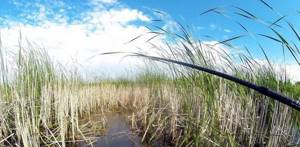
Fishing with a side nod is characterized by a high degree of dynamism, in which the angler constantly has to work with the rod, holding it suspended in his hands. These arguments require special criteria when selecting a fishing rod for the type of hunting presented. The fundamental one is considered to be the mass of the rod, which should be as small as possible.
Important! Low weight conditions include graphite telescopic rods in length sizes from 4 to 10 meters.
Depending on the intended use factors, the form can be equipped with guide rings or selected in a swing version. It is more convenient and more effective to use a rod with a semi-fast quiver tip action to make a jig retrieve. As one of the options for the basis of the nodding direction of catching fish, the equipment of a plug-type rod can be used.
It’s easy to make a side nod for summer fishing with your own hands. The basis for success is the selection of the right material for the product. The best examples of signaling devices are made from lavsan.
Important! Lavsan is a fairly common material in everyday life that is easy to obtain. This is a plastic bottle and an old fluorographic or x-ray photograph.
The surface of the bottle is cut, unfolding and straightening the material. Mark the workpiece, focusing on the shape of a long truncated cone of 25–30 cm with cut ends measuring 1 cm at the top and 3 cm at its base.
Having cut out the shape using scissors, a ring is made from a paper clip, which is mounted into the top of the accessory, piercing and subsequently impregnating the material with glue at the points of contact. For visibility, the tip of the alarm can be painted with varnish in a color that catches the eye.
An option for making a nodding tool could be a sheet of old construction tape and spring, flat-rolled steel. The main requirements for the material are elasticity and light weight.
For a novice angler, fishing with a summer side nod will seem not only exciting, but also a difficult challenge. The excitement and constant experimentation during fishing will not leave indifferent almost any person who was able to achieve the desired result: hooking cautious prey.
This type of fishing is used mainly in reservoirs and rivers where there are various types of fish. Roach, river perch and rudd most often bite on this tackle, but if the river contains chub, ide, crucian carp, and underbream, then these types of fish are no exception when caught.
Fishing with a summer side nod.
Catching carp with a nod seems to be quite effective. It should be noted that a float rod, as well as a donk using a side nod, are the most effective devices for catching carp.
As a rule, a stretching line is used, not exceeding 0.2 mm in diameter, which should withstand a 10-kilogram fish. The length of the fishing rod can reach 3.5-4 meters, with a reel (inertia-free) that has a friction brake.
With such gear, a fisherman can fish any place on a lake or pond.
In summer, carp stay near plant (reed) thickets, without swimming deep into them. It can hide if there are any at the bottom, under snags or depressions in the muddy bottom.
It can be caught both with a donkey and a float rod and at a depth of two meters. However, it is important to calculate the approximate location of its location and not scare the fish.
Only in this case, the carp will bite at the nod. The chosen place needs to be fed.
Carp goes well with corn, both sweet and fermented. .
A nod to carp using a summer jig is often used in stagnant bodies of water where this fish lives. In some cases, if the reservoir has a shallow bottom, the fisherman carefully walks with a fishing rod along the water along the shore to find a place where the fish are hiding.
Once this place has been found, the fisherman throws out the bait and waits for the carp to bite. If the weather is calm, the chance of successful fishing increases.
The main thing is to use the right bait, the appropriate size and always be fully prepared to hook.
Fishing with a jig in the summer is just as interesting as in the winter. The only difference is that it is chosen with greater weight. This is necessary to increase the sensitivity of the tackle and cast it, because in winter there is no need to cast it, it is lowered into the hole, which is under the fisherman’s feet.
- crucian carp;
- rudd;
- bream;
- silver bream;
- perch;
- tench;
- carp.
In the summer, with the appearance of the first scorching rays of the sun and the onset of heat and stuffy weather, almost all the fish go to the bottom or hide in the thickets. How to fish with a jig in the summer in this case? But I don’t want to be left without fish.
Experienced fishermen then begin to improvise and use all their tricks. For example, a very good way to get the fish to become active and stir it up is to slowly and carefully lower the jig with bait directly into the windows between the grass or algae.
Unlike the winter period, in the summer it is worth using darker colors of jigs. Accordingly, the color of the fishing line is chosen with a brownish tint. The nature of the game also differs; if in winter the game is slower and sluggish, then in summer it is worth increasing the pace of fluctuations. It should be noted that you need to fish with a fishing rod with a side nod and bites will be characterized not by the float, but by the side nod.
An important condition for successful fishing is the ability to play with a jig.
The choice and composition of gear largely depends on the method of fishing. For fishing from the shore, for example, you need a rod of about 4-6 meters, and for fishing from a boat, a two-meter rod is enough. Therefore, the choice of gear must be taken responsibly and take into account the nature of the fishing.
Choosing a rod. For jig fishing in summer, you need to select a light rod. Since “playing” from the shore with a six-meter fishing rod is not so easy, there is no need to take a longer rod. Currently, the lightest material for fishing rods is carbon fiber. Passage rings must be present, otherwise the line will always get tangled during the “game”.
The nature of the fastening of the gear. People distinguish between “deaf” and “running” gear.
- “Blind” or rigidly fixed tackle means that the tip of the fishing line is fixed to the end of the fishing rod, or a small reserve is wound on the reel, about the third knee. This method of fastening will not allow the line to be released at a sufficient distance when landing a good fish.
- “Running” or moving tackle is when the fishing line is threaded through guide rings and attached to a reel. The coil, in turn, can be inertial or non-inertial. This tackle will allow you to adjust the length of the released fishing line and effectively fight large fish.
- Nod. As mentioned above, a side nod is used for fishing. It is selected depending on the length of the rod and the weight of the jig. The longer the rod, the longer the nod. The ideal position of the nod is to have its tip slightly raised when the jig is empty. Experienced fishermen advise marking the tip of the nod with a bright color to make it easier to distinguish the bite.
- Mormyshka. As a rule, a jig for summer fishing is larger in size and weight than for winter fishing. Heavy jigs are used in strong currents or for catching large fish. Calm, not very intense movements can attract chub, ide, crucian carp, and sharp and fast movements can seduce perch.
To fish with a side nod you will need a long, stiff and light rod. The length is chosen according to this principle: it should be equal to the distance to the fishing spot, since the jig is at the level of the tip of the rod. If the rod is short, then you will only have to fish near the shore.
The rod should be light for the reason that it will be extremely difficult to work with a heavy “club”, and after a while it will become completely impossible to hold it in the desired position. Unfortunately, rods are not produced specifically for this tackle; you will have to select it yourself, guided by the above features.
The behavior of underwater inhabitants of freshwater bodies varies depending on the time of year. If at the beginning of autumn there continues to be a good bite on float and bottom fishing rods using plant and animal baits, then starting from the second half of October, the off-season begins for many fishermen. And only a few of them go fishing.
Before freeze-up, the fish continue to feed, accumulating nutrients before wintering. But at this time, representatives of the ichthyofauna switch to animal food.
Most often these are worms, bloodworms and other insect larvae. Float and bottom fishing rods are passive, the bait sinks to the bottom, and the angler has to wait a long time for the fish to approach.
Bait does not help at this time either, because... the water becomes cold, the aroma does not spread over a large area of water.
In winter, fishermen, using almost weightless fishing rods with light tackle, can play with bait with great frequency and only with movements of the hand. But when fishing in the summer, playing with a jig located at a considerable distance from the angler is both difficult and difficult.
Although the telescopic rod is made of carbon fiber to lighten the weight, holding and oscillating with such a “six-meter stick”, made even using modern technology and modern materials, is not an easy task, especially if you do it for several hours in a row.
A six- to seven-meter rod is the optimal choice: with a longer length, it becomes very difficult to control the tackle, and if the rod is short, then you can only fish directly near the shore, where it is impossible to catch serious fish.
When fishing with a jig, skillful play with tackle is the main component of success. But casting distance is also important. There are no special rods for jig tackle, so each angler must choose for himself a rod of the required length, most suitable for his fishing conditions.
You can even use a spinning rod to catch bait such as a jig.
One of the options for a side nod at the end of the rod
When choosing a fishing rod, you should pay attention to its lightness and length. At the same time, you need to remember that it will not have a classic bite alarm (in the form of a float).
Instead, bites will be transmitted to the nod (as in a winter fishing rod). But there are some nuances here, because the nod will be located at a considerable distance and its work is not so easy to see.
To make it more noticeable, it is attached to the side of the rod. Thus, the main element of such a fishing rod is its tip, which must have a certain rigidity and strength.
It must support its own weight and the weight of the nod along with the jig without bending. The nod is attached to the side of the tip using a special coupling.
The design of the nod can be any, but the most important thing is that while watching it (and it will take a long time to watch) your eyes do not get tired, and at the same time, it is clearly visible against the background of the sky and water, as well as the surrounding vegetation.
A good option is the dark green color of the nod itself with a bright designation at the end. It is perfectly visible and after long-term observation of it, your eyes do not get tired.
Making a summer side nod
To make a side nod, you should immediately decide on the material. Many experts recommend using the following materials for this:
- strips from plastic bottles, which are cut with ordinary scissors.
- springs from a clock mechanism.
- made of metal packaging strips that are used to secure cargo.
- from a construction tape.
- from a broken fishing rod or spinning rod.
It’s easy and affordable to use a plastic (at least liter) bottle that has a smooth side surface. In addition to the bottle, you need to have scissors, a needle file, a paper clip and regular thread.
The body of the nod is cut out from the side surface of the bottle, and it has the following dimensions: length 20-30cm, width of one of the bases 0.7-1cm, and width of the other end (top) 0.3-0.5cm. All cut lines must be smoothed and a needle file can be used for this.
A ring is formed from a paper clip, but first you need to straighten the paper clip and make it even. The ring is made in such a way that it has two legs that will hold the ring on the top of the nod. The legs are wound with regular thread (tightly) and waterproof glue is applied.
For effective fishing, it is worth making several nods of different sizes, for different fishing conditions. Harder ones are suitable for heavy baits, and softer ones are suitable for lighter ones. As a result of experiments, you can choose a nod for a certain type of fish.
A good option for making a summer nod from a broken fishing rod or spinning rod. This option is more versatile, as it can be suitable for various fishing conditions.
A nod of appropriate size and shape is cut out of the broken ring. Then the edges are smoothed with sandpaper and a file.
The nod ring is made from a paper clip, as in the first option, or can be used from a broken fishing rod. The ring is also attached to the top of the nod with threads and impregnated with waterproof glue.
After manufacturing, it is advisable to decorate the nod so that it is clearly visible. Any coloring with one paint or a combination of two colors will do, then the nod will be much more noticeable. The main thing is that the slightest touch of the fish on the bait is visible.
Making a winter side nod yourself
Such nods can be made from the same material as summer ones and using the same technology. The difference between summer and winter nods is only in size: the usual length of a winter nod is 5-10cm, and its thickness is 0.5-0.7cm at the base and 0.5-0.1cm at the top.
The making of a nod should be approached with the utmost seriousness, as this is the main element of the tackle. All bites are transmitted to it and the outcome of the entire fishing depends on how correctly it works. It’s not enough to make and hook the nod; you still need to adjust it so that it doesn’t bend under the weight of the bait, otherwise there will be false positives.
Each angler has his own version of the nod and considers it the best. Some fishing companies use wild boar bristles to make a nod for winter fishing.
Fishing is one of the most interesting types of recreation, when a person relaxes while fishing, no matter what kind. Some are interested in walking kilometers along the banks of a reservoir, while casting a spinning rod for the thousandth time, others prefer feeder fishing, and still others, traditionally, fish with an ordinary classic fishing rod.
But some people walk along the banks of a reservoir with a rod equipped with a side nod. Of course, this activity is not for the weak, just like spinning fishing, when kilometers are covered in a day, and the tackle has been in the water so many times that the hair rises on your head.
Yes, it’s hard, but it’s also very interesting, especially at the moments when any kind of fish is caught. And if a trophy specimen bites, then joy will know no bounds.
Over the years, so many tackles and methods of catching fish have been invented that sometimes you think that the poor fish will not survive. This is especially true for more modern or, as they are also called, more “advanced” fishing methods.
Here it is appropriate to remember the electric fishing rod, as well as how much harm it has brought to our reservoirs, as well as to fish. After all, it’s no secret that all fish located in the area of effect of the electric rod are affected, including small fish.
Rigging a fishing rod with a side nod
When fishing with a side nod, anglers use two types of equipment: blind and running.
Blind equipment
When using a blind rig, the fishing line is stored on a special reel, which is attached to the second leg of the rod.
If this is a replaceable reel, then it is desirable that one of its rings is movable (see figure),
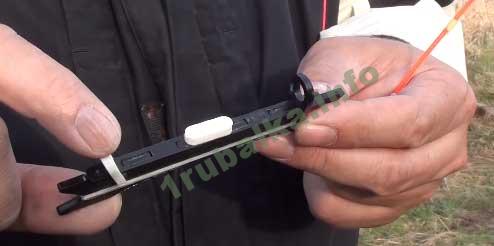
then, when fighting a large fish, the reel will not slip to the edge of the cone rod, since the movable ring will jam at this moment. If your rod does not have rings, and you are fishing with a light 0.25-0.1 gram jig, then your line will begin to blow out in the wind. In this case, it is better to use intermediate rings.
This kind of equipment has a lot of disadvantages, so in order to remove the trophy from the hook, change the jig or increase the length of the equipment, the fishing rod must be partially assembled. Also, the presence of a reel on the knee worsens the overall structure of the rod, and a small amount of fishing line does not make it possible to absorb the jerks of the fish.

But such equipment is simpler and cheaper. It is good to use it on cautious fish when you are fishing with small jigs, and with this equipment it is also more convenient to move along the shore, fishing interesting areas.
Running rig
Fishing with a side nod with a running rig gives the angler significant advantages when hunting for large specimens. This fishing rod is equipped with rings and a reel, which allows you not only to store a significant supply of fishing line, but also protects the tackle from breaking, thanks to the presence of a friction clutch. During the fishing process, we can adjust the amount of fishing line, reel it in or release it, which is convenient when fishing in the wind, as well as in areas where there are many tubercles and holes.
When fishing with a side nod with a sliding rig, we have the opportunity to make a retrieve, floating the jig downstream and fish difficult areas, such as the crowns of bushes or overgrown, washed-out banks.
Another advantage of the running rig is that when hooked, we can release the line, put the rod aside and pull on it until it breaks or the hook straightens. In this case, we eliminate the possibility that a fishing rod with a side nod will break.
Jigs
In the summer you can fish with a jig in all possible ways.
Large jigs are used for summer fishing. This is due to the fact that the tackle is not as sensitive as winter tackle; after all, the length of the rod is several meters and it would be unrealistic to notice the winter nod signal at such a distance.
Accordingly, all elements of the equipment must be in balance, in particular, the weight of the jig must correspond to the load-carrying capacity of the nod. These can be large lead jigs, or to reduce the size of the bait, use tungsten jigs, which, with the same weight, are much smaller than lead jigs.
Summer jigs are usually larger than winter jigs. Moreover, the heaviest of them are used when fishing in reservoirs with large currents or depth. And also when they are going to catch obviously very large fish.
How to make (choose) a side nod
You can make a side nod yourself or purchase it in a store, but it is worth considering that soft nods are needed for light baits, and harder ones for heavy ones. A correctly selected side nod bends 5-6 cm under the weight of the jig.
As a rule, anglers choose side nods that are 20-25 cm long.
Side nod from a plastic bottle
The simplest and most common way. First you need to make a workpiece 20 cm long, on one edge of the workpiece a width of 0.7 cm (base), on the other -0.5-0.3 cm (end). As a result, we see how our side nod gradually narrows in width, from the base to the edge. Then we process the edges of the side nod with a knife so that they become smooth.
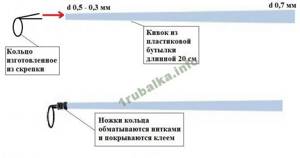
Now, take a paper clip, bend it and make a ring from it with two antennae, bent in relation to the ring at an angle of 90 degrees. Using these antennae, we attach a ring to the end of the nod, for which the antennae and nod are wrapped with thread and moistened with glue. For better visualization, the tip of the nod should be opened with bright-colored varnish. You can also attach the side nod to the rod using threads.
Fishing rod with a side nod from a construction tape measure
If you are using a heavy jig, then a bottle nod will not work for you. For such jigs, it is better to use a nod made from a construction tape. We take metal scissors and cut the workpiece to the same dimensions as in the case of a plastic bottle, then we grind the edges with a file or sandpaper.
Next, we tie a fishing line with a jig to the thin edge of the nod; the nod should bend by 5-6 cm, which will mean that it is suitable for a jig of this weight. Next, we attach a ring from a paper clip and paint the tip in a bright color.
Rod knee
You can also make a side nod from the knee of a broken fishing rod, and you will get a lot of nods.
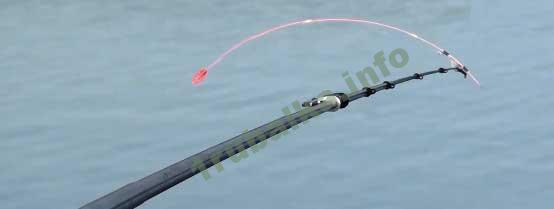
We do it according to the proven scheme, first we cut out blanks from a broken form, then we clean them, attach a ring from a paper clip to the thin edge, and a side nod for catching various scaly ones, ready.
How to Attach a Side Nod to a Fishing Rod
To put on a nod, you first need to remove the tulip from the fishing rod. Why do we heat it slowly so that the glue loses its properties? It is advisable to do this with the help of a hair dryer, or, in extreme cases, a lighter, moving it from side to side, avoiding direct contact of the flame with the tulip.

You also need to be careful and not allow the rest of the rod to heat up. Then, wrapping the tulip ring in a rag or wearing gloves (so as not to get burned), pull it and remove it from the tip of the rod. Now we clean the surface of glue residues, both on the whip itself and inside the removed tulip ring.
Then we put the ring back, take the side nod and the thermal tube and apply them to the tulip. Thermal tubes must be cut so much that they are several centimeters longer than the leg of the side nod. We remove the tulip ring again, thread the thermal tube through the whip, then apply glue to the tip of the whip and put the tulip back on.
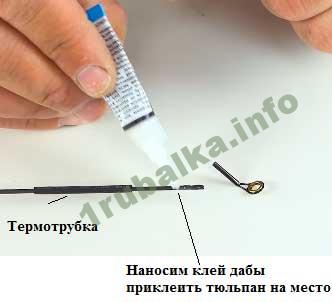
We wait until the glue dries and our ring will sit firmly on the rod again. Now we thread the nod leg, as shown in the figure. Next we put on the thermal tube.

The side nod is set so that the line that comes out of the rod's guide ring enters the side nod rings at an angle of 90 degrees.
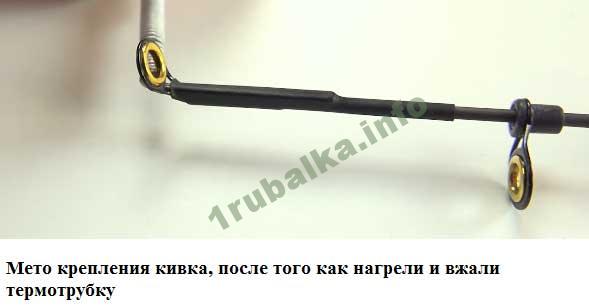
Now, with the help of a lighter or hair dryer, heat the heat tube and press it into the nod. The fishing rod with a side nod is ready.
Fishing technique with a side nod
Playing with a jig, when fishing on a fishing rod with a side nod, is not particularly different from winter.
The following methods can be distinguished:
- Bottom game - we regularly raise the jig to a height of 5-7 cm, and then lower it back;
- Lifting game - we first raise the jig 10 cm from the bottom, make small vibrations with it (by tapping the rod with a finger), then again raise the bait another 10 cm and so on. In this way you can determine where the fish is currently standing.
- Slowly moving the bait along the bottom, while moving the rod to the side.
- Falling game - we smoothly raise the bait to a height of 25-30 cm from the bottom, and then sharply let it fall, and repeat the technique again.
- We lower the jig into the bottom layer and gently tap the rod with our finger; as a result of such manipulations, the jig begins to oscillate in the water column, arousing the interest of the fish.
- We sharply raise the rod up to a height of 50-150 cm and then smoothly lower the bait back.
- If fishing with a side nod takes place in the current, then periodically it is necessary to float the bait down in a free float.
- In a gentle current, you can try to fish the middle layers of water, for which the current allows the bait to be carried a short distance, after which the fishing line is pulled, and the bait rises into the water column under the force of the current, while it still gives out a certain game.
Some fishermen in the current, instead of a reelless fly, use various flies.
In order to achieve success when playing with a jig, you need to constantly experiment, alternate or change the types of play with a jig.
Jigs
There is no doubt that the idea of transferring the winter method of fishing with a nod to summer conditions belongs to ice fishing lovers. Like most unexpected decisions, this idea turned out to be fruitful.
The bait ceased to be passive, which provided an additional incentive for the fish to pay attention to it and, as a result, increased the bite intensity and catchability of the new gear. There is also no doubt that nod fishing in summer requires a radical change in winter equipment.
The species composition of freshwater inhabitants that can get hooked is also widely represented. Depending on the type of reservoir, the catch includes the following representatives of ichthyofauna.
When fishing in lakes and ponds, you need to cast the jig as far as possible, and after it reaches the bottom, pull it jerkily or drag it along the shore.
The jig needs to be raised slowly, making stops, after which it needs to be lowered a little. While playing, you can tap your finger on the rod in the place where the reel is attached to create vibrations of the tackle at a certain frequency.
If the bottom of the reservoir is covered with vegetation, then the jig needs to be thrown into those places where there are no plants, and which are therefore called “windows”. The jig must be cast to the farthest point of the window, otherwise snags cannot be avoided during the game.
If the bait is live bait, then you can also catch pike with it, but most often perch is caught in the windows. During the fishing process, you need to move all the time: you shouldn’t stand in one place for a long time, if there is no bite, after making several unsuccessful casts, you need to go fishing in another window.
